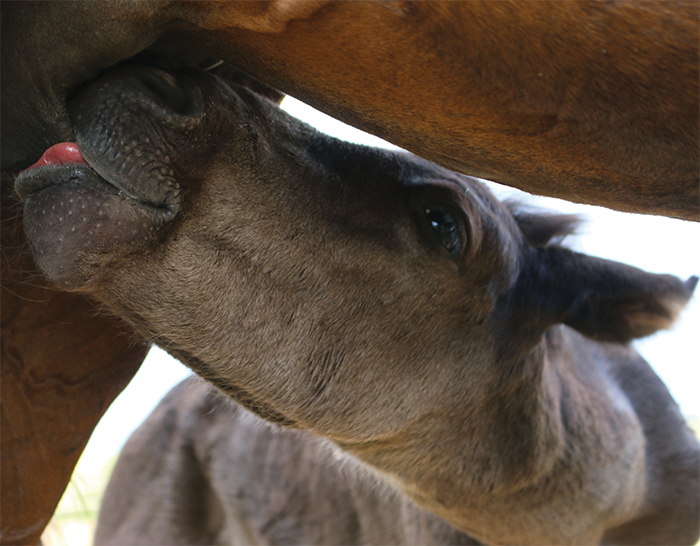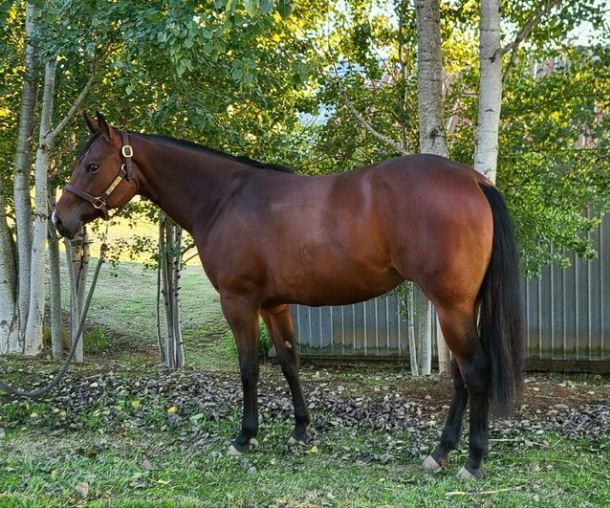
Tracie Plummer of Meadow Star Farm in North Plains, Oregon got a crash course in raising an orphaned foal in 2016 when her Quarter Horse mare, RL Illustrious, tore her uterus and had to be euthanized shortly after giving birth.
After several unsuccessful attempts to graft “Jimmy” onto other mares without success, Plummer trained the Batt Man colt to drink milk replacer from a bucket. But the process was stressful.
The milk replacer was expensive and had to be shipped cross-country.
“I slept in my barn for a couple of months as he would not drink the milk replacer if it got a tad cold,” she said. “It was just too much stress for me.”
So in 2019 when Plummer found herself again with an orphan foal she wanted to try something different.
Plummer’s good mare, RR The Moon N Back (by Only In The Moonlite and out of Im Sophisticated Sue) delivered a pretty bay filly by RL Best Of Sudden on a cold March night. At first, everything looked fine with the new arrival named “Winnie.” But within the month, her beloved mare died of a ruptured colon.
Plummer was heartbroken. She had already made plans to breed the sweet mare back to RL Best Of Sudden and once again was facing the reality of raising an orphan foal. This time she really wanted her foal to grow up with a maternal influence but there are only a small number of breeders close by so a suitable nurse mare could not be found.
But, Plummer had heard of another option – induced lactation – and she decided she wanted to give it a try.
The induced lactation process uses hormones to stimulate milk production in a mare that is not pregnant. Plummer had, on her own farm, My Dream Principle (Anna), a Principle Investment daughter that had been retired to her trail riding companion. Since the mare had foaled at least one previously, she was an excellent candidate.
“I was surprised at how quickly the process worked in the mare and that she started producing milk very soon after the onset of the protocol,” she said.
The mare also accepted the new foal, another hurdle that must be cleared when attempting the induced lactation process.
“My Dream Principle has a home here forever,” Plummer said. “She was just amazing.”
Forcing a mare into lactation isn’t most veterinarian’s first choice. Finding a nurse mare willing to accept an orphan is always their first preference. However, when a spare mare isn’t available on-farm, or nearby, bringing a mare into milk can be a better alternative to bottle feeding.
Making Milk
Equine reproduction expert Patrick McCue, DVM, Ph.D., Dipl. ACT often receives phone calls from breeders with orphaned foals at his laboratory at Colorado State University. Whenever a call comes in he first reaches out to his network to see if a nurse mare is available. Foals, in his opinion, are simply better off being raised through contact with another horse.
“It’s not unusual for someone in our geographic region to have something that happens to foal so they’ll call us up and tell us to have a potential nurse mare available for a couple of days or few weeks so that is our preference,” he said. “Some mares will take two foals: hers plus another.”
Dr. McCue considers inducing lactation as a last resort but says it can be a viable option when a nurse mare isn’t available. Many horse farms have another mare already on the property, or they know someone nearby with a mare available.
Not just any mare will do. A candidate must have had a successful, healthy pregnancy and delivery, and have a natural mothering instinct. If she meets those criteria hormones can be used to stimulate milk production.
“Through a series of hormone administration of estrogen and domperidone the mare will start to build a small mammary gland and will produce milk,” explained Ryan Ferris, MS, Dipl. ACT, an equine reproduction specialist. He and his wife, Dora, operate Summit Equine in Gervais, Oregon. “You need a mare that has a strong mothering instinct.”
Specifically, the hormone prolactin, which is produced in the anterior pituitary, triggers lactation. Currently, there is not a commercial prolactin treatment approved for use in horses. However, giving a mare a domperidone therapy is enough to encourage milk production.
“There’s a little bit of debate whether or not the mare needs to be cycling in normal estrus and ovulation to induce lactation,” said Dr. McCue. “We’ve induced lactation in mares that are not all cycling. Some people advocate progesterone or Regumate for a period of time, but we don’t feel like it’s needed.”
Fluid may start to accumulate as early as 24 to 48 hours with visible mammary development. It typically takes four to seven days of hand milking for enough to become available for the foal. The process often speeds up once the foal is grafted onto the mare.
Dr. Ferris is Plummer’s veterinarian and, under his guidance, she gave intramuscular Estradiol injections for three to five days to enhance the prolactin response to domperidone therapy. She also administered domperidone orally (Equidone). Her mare received 5 milliliters once daily for five to 10 days. A couple days after she started the process the mare started to get a milk bag.
“When I saw that the fluid expressed was indeed milk I followed the next step, which was to administer 3 milliliters. of Estrumate IM,” she explained. “I administered the Estramate and then along with my husband and friend, Elin, we waited about 15 minutes for the mare, Anna, to respond to the drug, she was quite sweaty and acting crampy. We brought the filly in and introduced her to Anna, they bonded immediately and the filly started nursing.”
Bringing the mare and foal together for the first time can be tricky and establishing a maternal bond is essential for success. Most mares show a deep interest in the foal. Keeping the foal hungry until the introduction is complete can help support the process and as in Plummer’s situation the introduction as seamless.
“I had Anna waiting in the stall Winnie had shared with her birth mother. Then we brought Winnie into the stall and guided her to the side of Anna. Anna reached around and started nuzzling Winne and then Winnie immediately nursed,” she said. “We exited the stall and allowed the bonding to continue. It was the most beautiful event I ever witnessed. We were all ecstatic, Winnie had a new Mommy.”
The Challenges to Induced Lactation
While considered a last resort, included lactation can be a better option than hand raising a foal. Young horses thrive through companionship with other horses. One of the drawbacks to using the process is the length of time it takes to bring a mare into lactation. Since it takes between seven to 10 days the orphan foal needs round the clock care until the mare is ready, Dr. Ferris said.
It’s also possible that after investing the time and expense into the process that the mare never comes into milk. That outcome is uncommon but should be taken into account. There is also a chance that after the mare is brought into lactation she rejects the orphaned foal.
The first 12 to 24 hours of a foal’s life are the most critical. This is when a mare’s milk delivers colostrum to help the newborn develop an immune system. Mares that die a few days to a few weeks after foaling have often had time to pass along the antibodies. Foals orphaned at birth won’t have that advantage. Milk produced through induced lactation will not provide colostrum. Without antibodies, the young horse will be susceptible to infectious disease.
“Veterinarians can give these antibodies via stomach tube, by bottle, or IV transfusion,” he said. “If a foal does not get antibodies will have a tough time early in life IgG needs to be checked to be sure have good colostrum intake passive transfer immunity.”
In these scenarios, Dr. McCue urges owners to regularly check the young foal’s IgG levels (the amount of immunoglobulin type Ge, an antibody) to determine if it has received enough colostrum from the mare. If not, colostrum supplements or plasma may be given to boost the foal’s immune system.
Getting Connected
Breeders know an orphaned foal is always a possibility. Hopefully, it never happens but having a backup plan in the rare chance that it does can make finding a replacement mare a quicker process.
“Nobody prepares or anticipates going to have an orphan at any one time,” Dr. McCue said. “Typically, we get one or two every year brought in from our geographic region. There may be a mare who has rejected a foal or she dies.”
Asking your veterinarian is one place to start. Connecting with nearby reproduction specialist in private practice or at universities can also help expand your network for finding mares to raise an orphaned foal.
“There are many local websites and social media platforms that will help link up orphan foals with nurse mares, or mares that have lost their foal,” Dr. Ferris said. “These groups can be great resources. If you identify these groups and join just in case you need them. Besides that most of the hormones are relatively common in a reproduction practice and will be stocked or can be obtained very quickly.”
As Plummer learned, when other options are unavailable, inducing lactation in a mare is a viable option. An alternative that eases stress for horse and human alike.
“I was so relieved when it worked with Winnie,” she said. “The process with Jimmy exhausted me and although he had a pony friend, I feel like having a real “mom” is irreplaceable. I was very apprehensive that I may fail but Ryan Ferris kept encouraging me and I am forever thankful for his encouragement.”






You must be logged in to post a comment Login